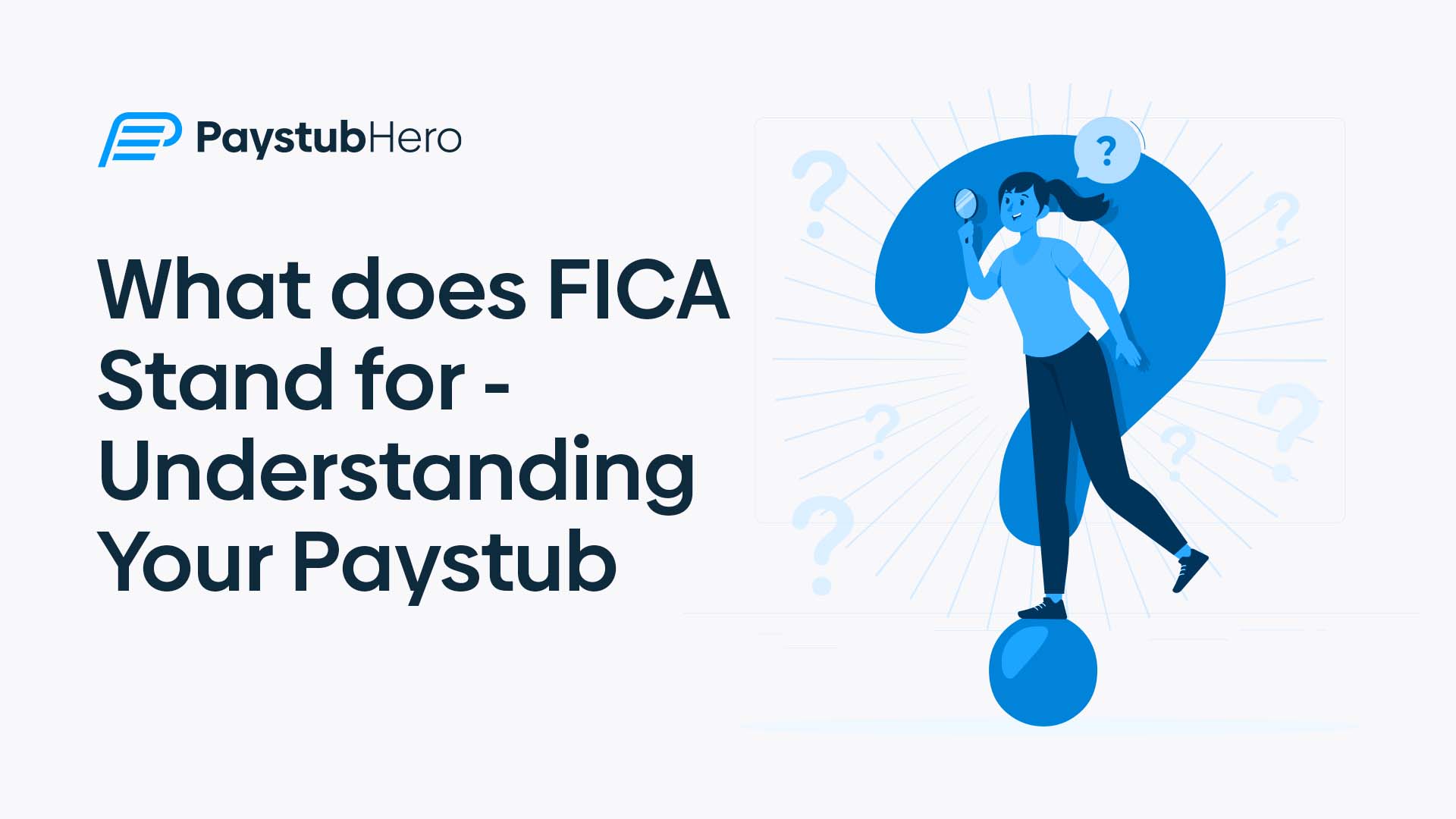What does FICA stand for? Unveiling the acronym is the first step to demystifying a crucial aspect of your paycheck. Have you ever found yourself staring at your paystub, completely befuddled by the jargon and abbreviations? You’re not alone. Amongst the various deductions, one that particularly stands out and is a constant on every paystub, is FICA. But what does FICA stand for?
FICA stands for Federal Insurance Contributions Act.
This three-word acronym plays a significant role in the American payroll system, influencing the earnings of millions of workers. The FICA contributions you see on your paystub are far more than just random deductions — they’re your ticket to some significant social benefits.
This article will delve into the FICA tax, helping you understand its composition, its relevance, and most importantly, its impact on your paycheck. We’ll decode the FICA tax rate and shed light on its implications for independent contractors, freelancers, and small businesses.
Our goal is simple: to equip you with the knowledge and tools to effectively manage this key component of payroll. No financial jargon, no complex theories—just straightforward, actionable insights that make understanding your paystub as simple as ABC.
So, whether you’re a solo entrepreneur trying to grasp the nuts and bolts of payroll taxes, or an employee looking to understand where your hard-earned money goes, we’ve got you covered.
Let’s start our journey to mastering payroll by understanding the core of our topic today — the Federal Insurance Contributions Act. FICA, as we now know, is a United States federal law that mandates a payroll tax on employees and employers to fund Social Security and Medicare — two vital federal programs that provide benefits for retirees, people with disabilities, and children of deceased workers.
We hope that with this knowledge, you’ll never have to wonder “What does FICA stand for?” again. Now that we’ve established a foundation, let’s dive deeper into the world of FICA taxes.
Table of Contents:
- Introduction: What Does FICA Stand For – Understanding Your Paystub
- The ABCs of FICA Tax: A Comprehensive Understanding
- Breaking Down the FICA Tax Rate: A Deep Dive Into the Numbers
- How to Manage FICA Taxes as a Solo-Entrepreneur: Empowering Action Through Knowledge
- The Paystubhero Solution: Streamlining Payroll Management for the Modern Entrepreneur
The ABCs of FICA Tax: A Comprehensive Understanding
Before we navigate the FICA landscape, it’s important to establish a strong foundation. Let’s explore what FICA tax is and what it’s composed of in greater depth.
As previously mentioned, FICA stands for Federal Insurance Contributions Act. While it might seem like a small line item on your paystub, FICA plays a gargantuan role in the grand scheme of American finance and social welfare.
FICA is a U.S. federal law that mandates a compulsory contribution from both employees and employers in the form of a payroll tax. The funds amassed through FICA taxes are primarily used to support two major federal programs—Social Security and Medicare.
These programs are essential for providing benefits for retirees, the disabled, and children of deceased workers. In essence, your FICA contributions are your investment into the safety net that supports you and countless others in times of need.
As you examine your paystub, you’ll notice that the FICA tax is a percentage of your gross wages. As of my knowledge cutoff in September 2021, the total FICA tax rate was 15.3%.
To break that down further, 12.4% goes towards Social Security, while 2.9% is allocated to Medicare. This distribution underlines the significant role Social Security plays in the U.S. social safety net.
With this basic understanding, we’ve cracked the code to the question, “What does FICA stand for?” But our journey doesn’t stop here.
Next, we’ll unravel the specifics of the FICA tax rate, which is a critical component for independent contractors, freelancers, and small business owners to understand and manage.
Breaking Down the FICA Tax Rate: A Deep Dive Into the Numbers
Deciphering the FICA tax rate is a crucial step towards mastering payroll management, especially for small businesses and independent contractors. A strong understanding of the FICA tax rate will provide a clear picture of your obligations and how to efficiently handle them.
Under the Federal Insurance Contributions Act (FICA), employees and employers both contribute to fund Social Security and Medicare. The total FICA tax rate, as of the last update in September 2021, stands at 15.3%.
To dissect this figure further, 12.4% of the tax goes towards Social Security, while 2.9% is directed towards Medicare.
In a traditional employment setting, the burden of the FICA tax is shared between the employer and the employee. Each party pays 7.65% of the employee’s gross wages.
This equitable division allows for the funding of these critical social programs without placing too much strain on either party.
However, the situation differs for those who are self-employed. Freelancers, entrepreneurs, and independent contractors are both the employer and the employee in their professional setting. As a result, they are responsible for paying the entire FICA tax rate of 15.3%. This is typically referred to as the self-employment tax.
This might seem like a heavy burden, especially for those just starting their entrepreneurial journey.
However, with careful planning, understanding the ins and outs of the FICA tax rate, and using the right tools, handling these tax obligations can become a seamless part of your business operations.
Next, we’ll delve into some actionable steps to help you manage your FICA taxes, mitigating any potential headaches and ensuring you’re equipped to navigate the tax landscape confidently.
How to Manage FICA Taxes as a Solo-Entrepreneur: Empowering Action Through Knowledge
Just knowing what FICA stands for is only the beginning of your journey into understanding and managing your payroll taxes.
As a solo entrepreneur, it is imperative to not only understand but also be able to manage your FICA taxes effectively. This management goes beyond just paying taxes—it’s about strategizing, planning, and optimizing your processes.
Here’s a comprehensive three-step process to efficiently manage your FICA taxes:
- Understand the FICA Tax Limit: The first step towards managing FICA taxes is to grasp the concept of the FICA tax limit. Not all of your income is subject to the Social Security portion of the FICA tax. There is a cap on the amount of income that can be taxed for Social Security. As of 2021, this limit was set at $142,800. Income beyond this limit is not subjected to Social Security tax but still remains subject to Medicare tax, which has no income cap. Familiarizing yourself with this limit can provide a clear picture of your FICA obligations.
- Track Your Earnings: To manage your FICA taxes, you need to be vigilant about tracking your earnings. It’s crucial to document your income accurately. A comprehensive record of your earnings will aid in calculating the exact amount you owe in FICA taxes, avoiding any surprises at the end of the fiscal year.
- Set Money Aside: Instead of facing a hefty tax bill all at once, it’s a sound strategy to set aside money regularly for your FICA tax. Consider this as another expense in your budgeting. This practice not only makes your tax payments more manageable but also promotes financial discipline.
While this three-step process offers a roadmap for managing your FICA taxes, it’s essential to remember that each business has unique needs. Therefore, you should tailor this guide to your specific situation.
Moreover, managing FICA taxes might seem daunting, especially when juggling various other business tasks. This is where professional tools and services can provide much-needed support.
In the next section, we’ll introduce you to Paystubhero, a solution designed to streamline payroll management for solo entrepreneurs, freelancers, and small businesses.
The Paystubhero Solution: Streamlining Payroll Management for the Modern Entrepreneur
As you juggle the myriad tasks involved in running a successful business, managing payroll taxes, like FICA, can often seem like a daunting task. It requires a keen eye for detail, an understanding of complex tax codes, and most importantly, a significant investment of your precious time.
Wouldn’t it be great if there was a tool that could simplify this process, allowing you to focus on growing your business?
Enter Paystubhero.
Paystubhero is an online payroll software designed specifically for the unique needs of entrepreneurs, freelancers, small businesses, and independent contractors.
Our aim is to equip these professionals with a robust, streamlined, and cost-effective solution for managing their payroll taxes.
Paystubhero is not just another payroll software—it’s a solution that caters specifically to solo entrepreneurs and small businesses who often don’t have access to large, big-business-focused software like ADP or Gusto.
We understand that these platforms, while comprehensive, often come with a higher price tag and a learning curve that can be prohibitive for smaller operations.
Our software takes a different approach. We’ve worked to create an easy-to-use, efficient solution for generating payroll documents.
All you have to do is enter your company and employee information, and our software does the rest. It will handle the calculations and produce accurate, detailed paystubs, taking the guesswork out of payroll management.
By leveraging Paystubhero, you can minimize errors, save time, and ensure that your business remains compliant with tax regulations.
All of this, while you maintain full control over your payroll processes.
Remember, managing your payroll doesn’t have to be a chore. With an understanding of FICA and the right tools, you can navigate the payroll landscape confidently and effectively.
Experience the difference that a dedicated, entrepreneur-focused solution can make in your payroll management. Explore the power of Paystubhero and take control of your payroll today.
Frequent Asked Question
Is Social Security tax and FICA the same?
- No, they are not the same. FICA includes both Social Security tax (12.4% of the total FICA tax rate) and Medicare tax (2.9% of the total FICA tax rate).
What is FICA and why do I have to pay it?
- FICA stands for Federal Insurance Contributions Act. It’s a mandatory payroll tax that funds Social Security and Medicare, vital federal programs that provide benefits for retirees, the disabled, and children of deceased workers.
Who pays FICA taxes?
- Both employees and employers pay FICA taxes. Each contributes 7.65% of the employee’s gross wages. For self-employed individuals, they are responsible for the full 15.3% as they are considered both the employer and employee.
Do you pay FICA on Social Security?
- No, FICA taxes are not paid on Social Security benefits. The FICA tax applies to earned income, such as wages or self-employment income. Social Security benefits do not fall under this category.








